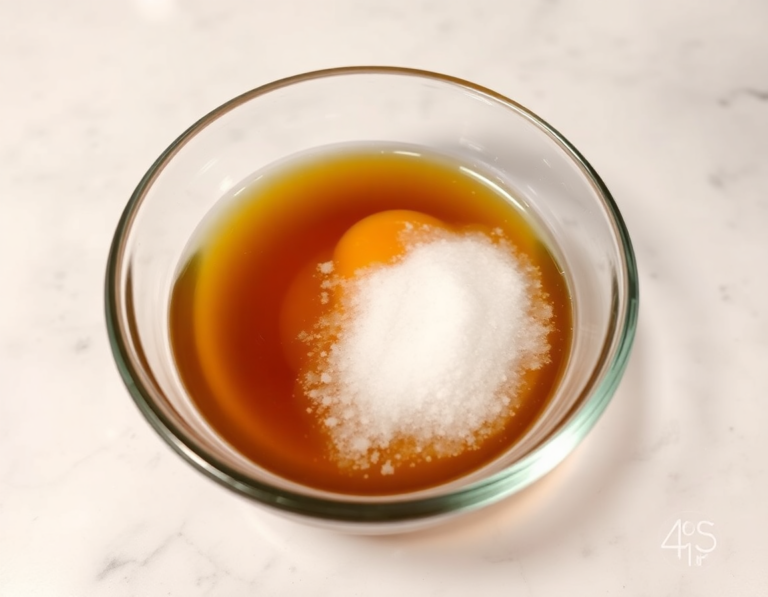I still remember the first time I tried gobo—it was at this quaint little sushi bar, hidden away in a bustling Tokyo alley. The earthy, slightly sweet taste of burdock root, perfectly wrapped in rice and nori, was a revelation! You won’t believe how such a simple ingredient can transform your sushi experience.
Steps
- Prepare the Sushi Rice: In a small bowl, combine rice vinegar, sugar, and salt, stirring until they dissolve. Mix this solution into the cooked rice until well incorporated.
- Prepare the Nori and Gobo: Cut nori seaweed sheets in half for the sushi rolls. Slice the pickled gobo into thin matchstick strips. Cover your bamboo sushi rolling mat with plastic wrap for easier cleanup.
- Assemble the Sushi Roll: Place a half sheet of nori on the bamboo mat. Wet your fingers to keep the rice from sticking and spread a thin layer of sushi rice over the nori. Flip the nori so the rice faces down, then arrange the gobo and any additional fillings along the center.
- Roll and Slice the Sushi: Using the bamboo mat, lift the edge and roll the sushi away from you, shaping and compressing the roll tightly. With a sharp, non-serrated knife, cut the roll into bite-sized pieces.
- Serve: Enjoy your gobo sushi with soy sauce, wasabi, and pickled ginger for added flavor.

Ingredients
- 2 cups cooked sushi rice
- 2 tablespoons rice vinegar
- 1 tablespoon sugar
- 1 teaspoon salt
- Yamagobo (pickled burdock root)
- Nori seaweed sheets, cut in half
- Optional for serving: soy sauce, wasabi, pickled ginger
Nutritional Values
Calories: 716 kcal | Carbohydrates: 164 g | Protein: 16 g | Fat: 1.2 g | Saturated Fat: 0.4 g | Polyunsaturated Fat: 0.4 g | Monounsaturated Fat: 0.4 g | Sodium: 2368 mg | Potassium: 1452 mg | Fiber: 20 g | Sugar: 24 g | Vitamin A: 260 IU | Vitamin C: 16 mg | Calcium: 200 mg | Iron: 4 mg
FAQ
- What is gobo sushi?
- Gobo sushi, also known as Burdock Root Sushi, is a distinctive type of sushi from Japan that features burdock root (gobo) as its primary ingredient. The burdock root is thinly sliced and marinated in a sweet and savory sauce before being rolled with sushi rice and other ingredients like cucumber or avocado.
- How does gobo sushi taste?
- The pickled burdock root in gobo sushi provides a tangy, sweet, and crunchy flavor, which contrasts nicely with the soft, seasoned sushi rice. The rice is flavored with rice vinegar, sugar, and salt, creating a balanced taste that complements the gobo without overpowering it.
- What is yamagobo?
- Yamagobo refers to pickled burdock root, a popular ingredient in Japanese cuisine. It is made by pickling burdock root with sugar, vinegar, and sometimes other seasonings, resulting in a slightly sweet and tangy taste with a crunchy texture. Yamagobo is commonly used in sushi rolls and other Japanese dishes.
- How should I store leftover gobo sushi?
- To store leftover gobo sushi, wrap it tightly with plastic wrap or place it in an airtight container and refrigerate. It’s best consumed within 24 hours to maintain its quality. Avoid freezing sushi, as it can alter the texture and flavor of the ingredients.
- Can I reheat leftover sushi?
- Sushi is traditionally enjoyed cold, and reheating it may negatively affect its taste and texture. If you prefer it warmer, allow the refrigerated sushi to come to room temperature before consuming.
Tips
- Select Fresh Ingredients: Always opt for fresh and tender burdock root to ensure the best texture and flavor in your gobo sushi. Similarly, using high-quality sushi rice will significantly enhance the overall taste of the dish.
- Use a Bamboo Sushi Rolling Mat: For creating neat and tightly packed sushi rolls, a bamboo sushi rolling mat is essential. It helps in shaping and compressing the roll, which prevents the ingredients from falling apart during slicing.
- Be Creative with Fillings: While gobo is the main highlight, don’t hesitate to experiment with additional fillings like cucumber, avocado, or pickled radish to introduce a variety of textures and flavors to your sushi.
- Slice with Care: Employ a sharp, non-serrated knife for slicing the sushi rolls. Wetting the blade between cuts can help achieve clean and precise slices, enhancing the presentation of your sushi.
Equipment
- Sushi Bamboo Rolling Mat (Makisu): Essential for rolling and shaping the sushi rolls tightly.
- Plastic Wrap: Used to cover the bamboo mat for easy cleanup.
- Sharp Knife: Necessary for slicing the sushi roll into bite-sized pieces. A high-quality, non-serrated knife is recommended for precise cuts.
